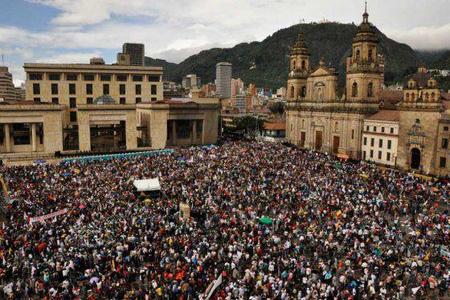The state is not winning the civil war in Colombia. It has become apparent that the unprecedented military expansion and billions of dollars invested in such endeavors have reached their limits. Now both main guerrilla groups, the Armed Revolutionary Forces of Colombia (FARC) and the National Libration Army (ELN), and other smaller groups have solidly retaken the military initiative for the first time since the inception of the $7 billion Plan Colombia in 2000. Plan Colombia was designed by the United States to avert the collapse of state and to defeat the insurgency.
There are two core factors that helped the insurgency regain the military-political initiative during the last three years, which was further consolidated this year: First, the FARC and the ELN have dispersed their fronts on a wider territory, strenthening their presence in areas in which they enjoyed popular support. Both groups also activated their links with the popular movements in cities, as was demonstrated in 2011 by the huge rally in the oil-city of Barancabermeja and again in their support of the Marcha Patriotica in Bogota earlier this year.
Secondly, FARC’s Rebirth Plan, which was adopted in 2008, provided more autonomy to its commanders, allowing them to adjust more rapidly to a changing war environment. The ELN’s local commanders have historically enjoyed such autonomy. Through the Rebirth Plan, the FARC created mobile and specialized units and these “special forces” have proven to be effective in the last three years. The increased autonomy and mobility is paying off.
Some indicators for insurgency re-taking the military initiative:
1. The insurgency's ability to choose where to fight, as demonstrated in the departments of Narino, North Santander, Arauca, Putumayo and lastly Cauca, which culminated in the downing of a Super Tucano fighter jet and the deaths of its two pilots few weeks ago.
2. Since 2009, FARC has increased its attacks, consistently establishing a trend. For example, according to Colombia’s Ministry of Defense, FARC increased its attacks by 57% from those recorded in 2011. Those attacks have also become more lethal: between 2009 and 2011 more than 7,000 soldiers were killed and injured in combat.
3. The insurgency forces are again vigorously targeting the main rents of the state, chiefly oil and coal, forcing the state to divert one-third of its military to protect oil pipelines and mining areas. Currently there are about 78,000 soldiers protecting strategic economic assets, meaning that there are more soldiers protecting installations than fighting.
4. Finally, the insurgency attacks are leaving a dent in the state's coffers. It is estimated that the guerrillas’ attacks against pipelines and other related installations are causing a daily income loss of $1 million. On the other hand, the insurgency is capable of increasing its leverage to extract rents from the operating multinational corporations helping in sustaining its military capability. Ecopetrol, a mixed company, which controls 70% of the country’s oil production, lowered its daily production from 800,000 to 780,000 barrels, mainly because of the guerrilla attacks.
The above shows the evolving dynamics of the war system in Colombia and demonstrates the fluidity of this civil war, partially explaining the inability of the state to win it.
Nazih Richani is the Director of Latin American studies at Kean University. He blogs at nacla.org/blog/cuadernos-colombianos.

